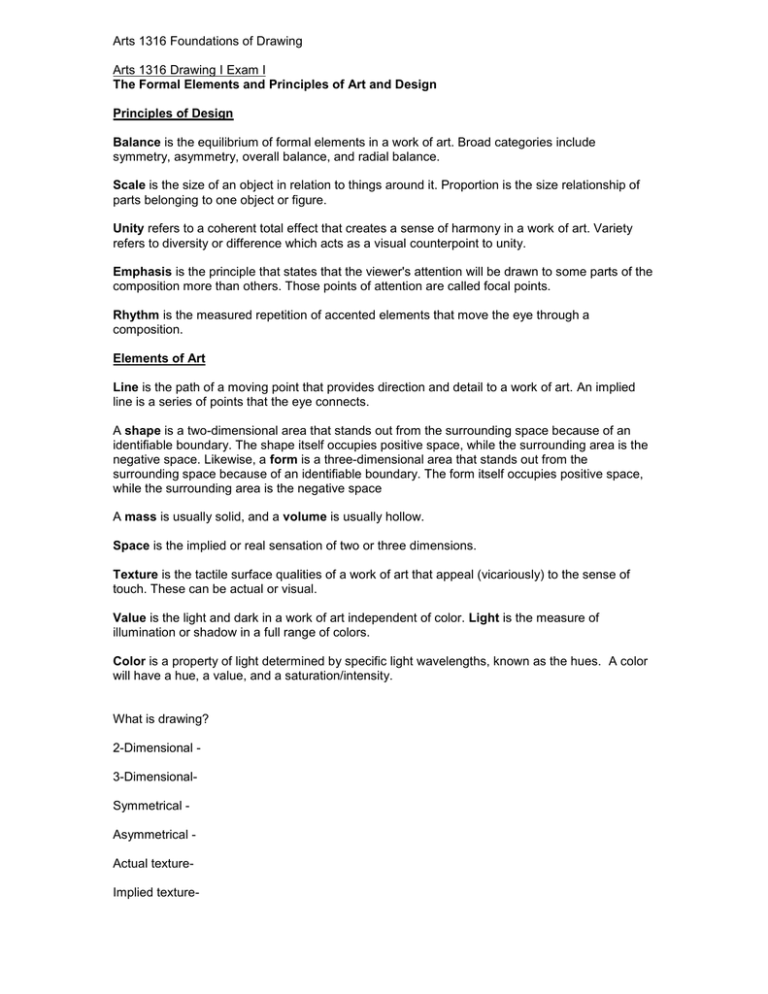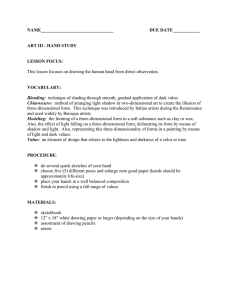Arts 1316 Foundations of Drawing Exam I Review.doc
advertisement

Arts 1316 Foundations of Drawing Arts 1316 Drawing I Exam I The Formal Elements and Principles of Art and Design Principles of Design Balance is the equilibrium of formal elements in a work of art. Broad categories include symmetry, asymmetry, overall balance, and radial balance. Scale is the size of an object in relation to things around it. Proportion is the size relationship of parts belonging to one object or figure. Unity refers to a coherent total effect that creates a sense of harmony in a work of art. Variety refers to diversity or difference which acts as a visual counterpoint to unity. Emphasis is the principle that states that the viewer's attention will be drawn to some parts of the composition more than others. Those points of attention are called focal points. Rhythm is the measured repetition of accented elements that move the eye through a composition. Elements of Art Line is the path of a moving point that provides direction and detail to a work of art. An implied line is a series of points that the eye connects. A shape is a two-dimensional area that stands out from the surrounding space because of an identifiable boundary. The shape itself occupies positive space, while the surrounding area is the negative space. Likewise, a form is a three-dimensional area that stands out from the surrounding space because of an identifiable boundary. The form itself occupies positive space, while the surrounding area is the negative space A mass is usually solid, and a volume is usually hollow. Space is the implied or real sensation of two or three dimensions. Texture is the tactile surface qualities of a work of art that appeal (vicariously) to the sense of touch. These can be actual or visual. Value is the light and dark in a work of art independent of color. Light is the measure of illumination or shadow in a full range of colors. Color is a property of light determined by specific light wavelengths, known as the hues. A color will have a hue, a value, and a saturation/intensity. What is drawing? 2-Dimensional 3-DimensionalSymmetrical Asymmetrical Actual textureImplied texture- BackgroundCalligraphy Charcoal Chalk and Crayon Blind Contour Contour Drawing – Overlapping- Obscuring of part of an image by another one that seems to lie between it and the viewer. Plane Structure- Analysis of a 3D form as a series of flat surfaces. Stippling – Hatching Cross-Hatching Lost and Found Lines Pastel Pen, Brush and Ink Wash Dry Media Preliminary Study Illustration Transparency- A composition in which a distant plane can be seen through a closer one. Gesture Cast Shadows Shading One-Point Perspective Vanishing point- The point on the horizon at which converging parallel lines appear to meet. Value scale – Negative- Descriptive of areas in a work that appear to be unoccupied, or empty. Figure- In 2-D work, an image that appears to be somewhat closer to the viewer than the background against which it is presented; also referred to as a positive shape. Ground- The initial surface of a two-dimensional design. The area of a 2-D work that appears to be farthest from the viewer: also called “background” Foreground- A 2D work that creates an illusion of three dimensionality, the area that seems closest to the observer. Spactial- Pertaining to or creating the illusion of space Foreshortening – Expressive drawing Chiaroscuro – ContentEye-level lineIntuition- The act or faculty of knowing or sensing without the use of rational processes Intuitive Gesture- is a quick, all encompassing overview of the wholeness of forms and their relationship in space. It is energetic, flexible, nonlinear, nonspecific, intuitive, and constantly open for suggestion. Representational- Descriptive of art that depicts objects from the world of our experience. Surreal- Like pictures from a dream or the unconscious mind. AbstractPhotorealism- 1. 2. 3. 4. 5. 6. 7. highlight light shadow core of shadow reflected light reflected Shadow cast shadow
